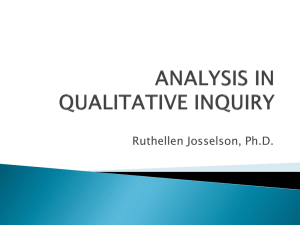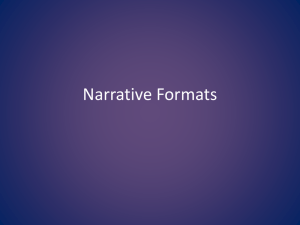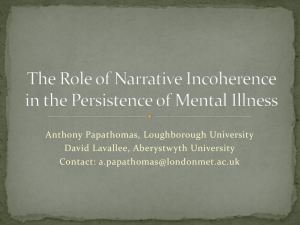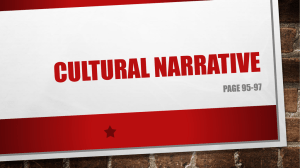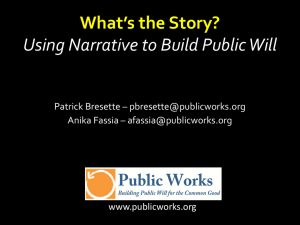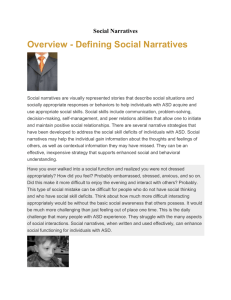Content analysis in scientific narrative psychology
advertisement
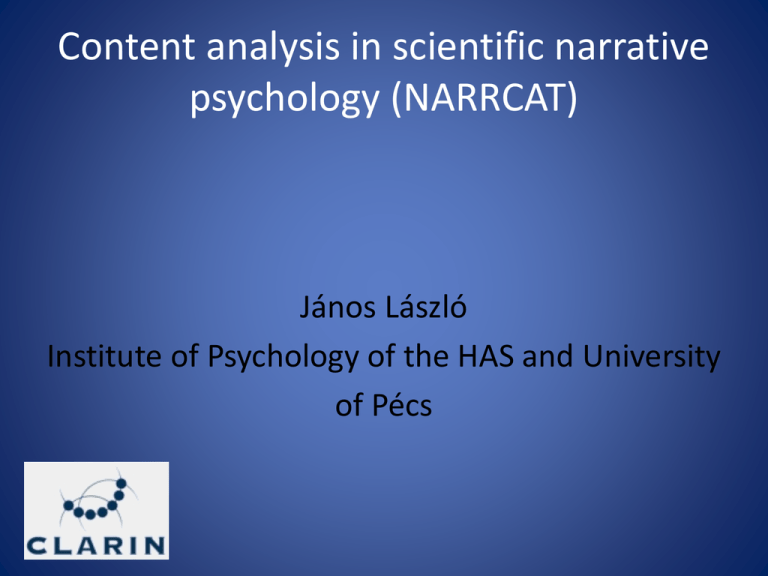
Content analysis in scientific narrative psychology (NARRCAT) János László Institute of Psychology of the HAS and University of Pécs Narrative • Narrative text: temporally and causally organized sequence of propositions • Narrative thinking: innate capacity to establish rational, causal order of events Narrative and identity • Non-essentialist concept of self: narrative identity • Self as life story (Erikson, 1959; MacAdams, 1985; Ricoueur, 1991) • Psychological concepts: identity crisis, identity closure, identity trauma • Psychological dimensions of identity in life narratives: complexity, maturity, integrity Group narratives • Collective representations of group events (group history) • Similarities and differences with individual life story – Standard life course vs beginning and termination is open ended – Developmental tasks are well defined vs development depends on actual needs for persisting and growth. • Although individual life stories are also preformed by social and cultural standards, they are subjectively accessible. Whereas group histories only exist in written or oral discourse How to squize out identity related content from life stories and from group histories? • Content analysis – Qualitative – Quantitative • Hermeneutic, qualitative analysis of narratives – Interpretation of themes of life narrative against the sociocultural knowledge horizon in psychological terms – No empirical test of validity Aid of computer technology to qualitative analysis • Correlational techniques in content analysis (Weber, 1983; Hogenraad, MacKenzieand Péladeau, 2003) – Emprically aided hermeneutics – Co-occurence of words in the text shed light to hidden themes Computerized quantitative content analysis • (Psychological) categories dictionaries – Testing any kind of plausible hypotheses • Problem of dictionaries: disambiguation, lemmatization (particularly in agglutinative languages) • Introduction of grammatical categories and function words into dictionaries – E.g. tens or self reference with postfixes • Full morphological analysis is needed • Morphological analysis enables grammatical analysis • NooJ enables both Role of grammar • Grammar enables complex psychological categories reflected in modalities such as intentionality • I like to teach versus I would like to teach • Intentionality + activity (dictionary of active vs passive verbs) = AGENCY • Agency is a narrative category Narrative categories • • • • • • • • AGENCY SPATIAL TEMPORAL PERSPECTIVE PSYCHOLOGICAL PERSPECTIVE TEMPORAL ORGANIZATION EVALUATION CHARACTERS AND THEIR FUNCTIONS EMOTIONAL ORGANIZATION SPATIAL-EMOTIONAL DISTANCE REGULATION Further categories • Negation • Self-reference • Us-reference – In self-narratives and group narratives can be interpreted as narrative categories Narrative structure-narrative composition • Agency – Who is agent and who is passive? – When is a group active and when is it passive? • Evaluation – Ingroup-outgroup evaluation • Emotions – Type of emotios that the ingroup and outgroups feel • Etc • Traditional social psychological issues of group identity and intergroup relations studied by CA Two major features of narrative categorial content analysis (NARRCAT) 1. It is directed to the meaning construction by narrative composition in life narratives and group narratives 2. It transforms narrative composition into narrative categories and makes it amenable to categorial i.e. nomothetic content analysis





